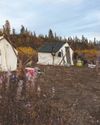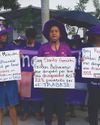On January 1, 1994, the Zapatistas’ armed uprising seized several cities and towns in southern Mexico, on the same day that the NAFTA agreement took force. Now, as Trump threatens to rip up NAFTA and others seek to “modernize” it, it’s once again Indigenous peoples who will bear the fallout of neoliberal policies.
In March of 2018, thousands of self-identified women Zapatistas and activists gathered in Chiapas to share their struggles and victories in building a world beyond capitalism.

The Spanish sign on the side of the hill doesn’t mince any words: “You are in Zapatista autonomous territory. Here the people lead, and the government obeys.” That sign welcomes us into the Caracol of Morelia in Chiapas, Mexico, for the First International Gathering of Women in Struggle, held over five days in March 2018. I am one of over 5,000 (self-identified) women activists from around the world, hosted by over 2,000 Zapatista women from across their territory, who have travelled here to share our struggles. Some of the women I’m travelling with are Indigenous land defenders and culture keepers from North America; others are the children and grandchildren of Latin American migrants who were displaced from their homes by the very forces the Zapatistas have been fighting against for three decades; still others are activists like me, descendants of European invaders on Turtle Island looking for some way out of the destructive culture that our predecessors built. Could what the Zapatistas have created show us a way to do that? I’m here to see for myself.
A POETICS OF REVOLUTION
The Zapatistas burst onto the international scene on January 1, 1994, the day that the NAFTA agreement took force, when their armed uprising seized several towns and cities in the southernmost state of Mexico. But for more than a decade before, the Zapatistas had been slowly building a clandestine movement to reassert the dignity and autonomy of their communities.
この記事は Briarpatch の July/August 2018 版に掲載されています。
7 日間の Magzter GOLD 無料トライアルを開始して、何千もの厳選されたプレミアム ストーリー、9,000 以上の雑誌や新聞にアクセスしてください。
すでに購読者です ? サインイン
この記事は Briarpatch の July/August 2018 版に掲載されています。
7 日間の Magzter GOLD 無料トライアルを開始して、何千もの厳選されたプレミアム ストーリー、9,000 以上の雑誌や新聞にアクセスしてください。
すでに購読者です? サインイン

PLATFORMS FOR PEOPLE, NOT PROFIT
Digital platforms boast that they’ve “democratized” cultural production. But what would truly democratic platforms look like in Canada?

ORGANIZING THROUGH LOSS IN THE HEART OF OIL COUNTRY
The story of climate justice organizing in Alberta, at the heart of the tarsands, is the story of a group of young activists learning what it means to lose, and keep on fighting

GROWING THE LABOUR MOVEMENT
How unions are using community gardens to engage members, nourish communities, and help strikers weather the picket line

A NEW ERA FOR OLD CROW
In the Yukon’s northernmost community, the Vuntut Gwitchin First Nation is reckoning with how to preserve their land and culture, amid a warming climate and an influx of tourists

“At Least Hookers Get Wages”
The risky business of sex work in the gig economy

The Literal – And Literary – Futures We Build
Briarpatch editor Saima Desai talks to two judges of our Writing in the Margins contest about Idle No More and MMIWG, ethical kinship, writing queer sex, and their forthcoming work.

The Cost Of A T-Shirt
In Honduras, women maquila workers are fighting back against the multinational garment companies that they say are endangering their health and safety.

Milking Prison Labour
Canada’s prison farms are being reopened. But when prisoners will be paid pennies a day, and the fruits of their labour will likely be exported for profit, there’s little to celebrate.

Bringing Back The Beat
In mainstream media, labour journalism has been replaced by financial reporting and business sections. But journalism students are raising the labour beat from the grave.

There's No Journalism On A Dead Planet
Corporate media owners are killing local newspapers – which is making it impossible for everyday people to understand the on-the-ground impacts of the climate crisis